Who Controls the User Experience? AMD’s Carrizo Thoroughly Tested
by Ian Cutress on February 4, 2016 8:00 AM ESTComparing AMD Carrizo to Intel Core
While generational updates are a crucial part of the examination, there has to be comparison with the competition. Intel has an overriding advantage in process node, meaning that performance per watt is difficult to compete against, but also OEMs seem unwilling to use Carrizo in the same device designs as they do with Core either due to partnerships or other issues (e.g. ASUS UX301/UX305 uses 15W Core i5). Nonetheless, Intel’s product line is a sequence of parts that intersect each other, with low end models equipped with dual core Pentiums and Celerons, stretching into some i3 and i5 territory while still south of $1000. In this mix is Core M, Intel’s 4.5W premium dual core parts found in devices north of $600.
| AMD Carrizo vs Intel Core | ||||||||
| SoC | A12-8800B | FX-8800P | i5-5200U | m3-6Y30 | i5-6300U | i7-6600U | ||
| CPU | Carrizo 2M/4T >3.4 GHz |
Carrizo 2M/4T >3.4 GHz |
Broadwell 2C/4T >2.7 GHz |
Skylake 2C/2T >2.2 GHz |
Skylake 2C/4T >3.0 GHz |
Skylake 2C/4T >3.2 GHz |
||
| CPU TDP | 15W | 15W | 15W | 4.5W | 15W | 15W | ||
| GPU | R7 GCN 1.2 512 SPs 800 MHz |
R7 GCN 1.2 512 SPs 800 MHz |
HD 5500 Gen8 24 EUs 900 MHz |
HD 515 Gen9 24 EUs 850 MHz |
HD 520 Gen 9 24 EUs 1 GHz |
HD 520 Gen 9 24 EUs 1.05 GHz |
||
| DRAM | 1x4GB DDR3 1600MHz |
1x8GB DDR3L 1600MHz |
2x8GB DDR3L 1600MHz |
2x4GB DDR3L 1600MHz |
2x4GB DDR3L 1600MHz |
2x8GB LPDDR3 1866MHz |
||
| Storage | 128GB SSD |
750GB HDD |
256GB SSD |
256GB SSD |
256GB SSD |
256GB PCIe |
||
| SoC Price | ~$150 | ~$150 | $281 | $281 | $281 | $393 | ||
As part of this comparison, we took our results from the 15W Carrizo laptops home and put them up against several Intel parts. The main comparison point is the i5-5200U, a 15W Broadwell part from Intel (in this case from the BRIX mini-HTPC I have at home) and the i5-6300U, a 15W Skylake part from the Surface Pro 4. Both Intel parts have a slightly lower frequency than the top-end Carrizo parts, but match Carrizo's 2MB L2 cache while also implementing a 3MB L3 cache, which gives them an advantage in cache-limited scenarios. The Skylake i5, compared to the Broadwell i5, uses a newer architecture and increased frequencies, and both are made on 14nm rather than 28nm, which gives Intel a significant process node (and by extension a perf/watt) advantage.
To add some more interesting points into the mix, we have also pulled in some results from the ASUS UX305, a Skylake-Y based Core M device at 4.5W. Our UX305 uses a lower-end m3-6Y30, but it gives us an idea of how very low power Core fares in comparison to 15W Carrizo. Meanwhile at the opposite end of the spectrum we also have thrown in an i7-6600U system, one of Intel's top 15W SKUs, allowing us to compare the best 15W part from AMD to the best 15W part from Intel. That said, given the current performance realities of the CPU market, it is worth noting here that the these parts are in two different segments to Carrizo based on price/performance and performance/watt ($393 for the i7-6600U alone can be as much as a full Carrizo laptop).
First up, a selection of CPU tests:
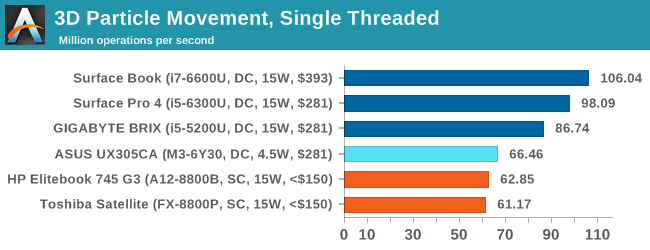
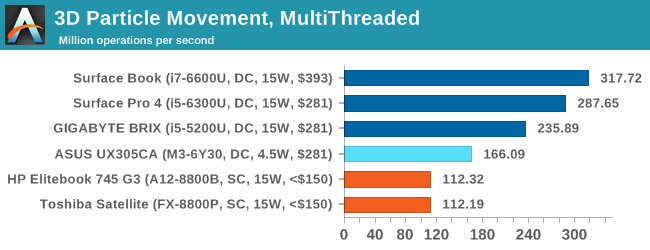
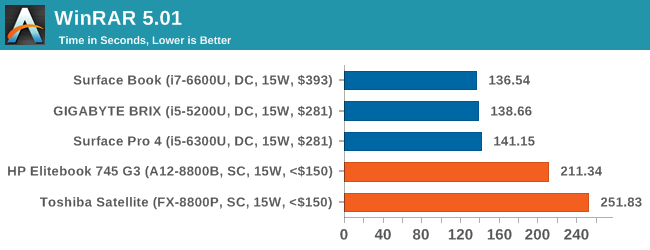

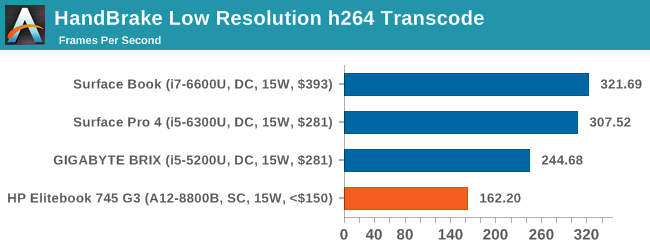

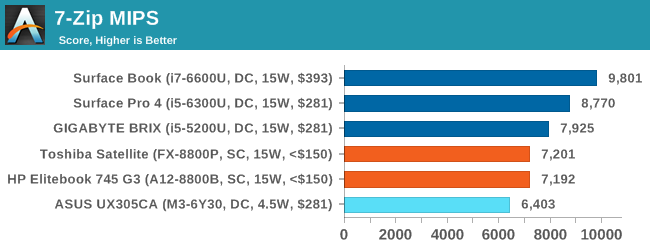
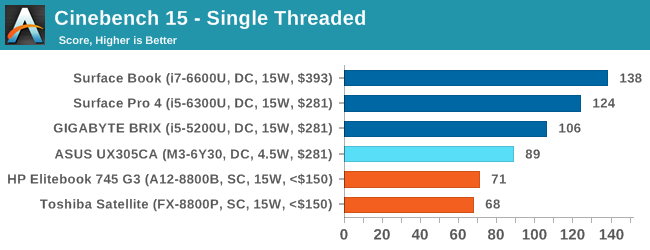
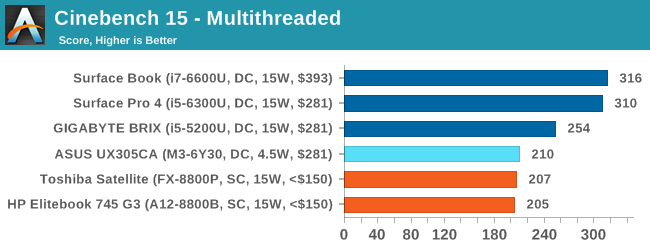
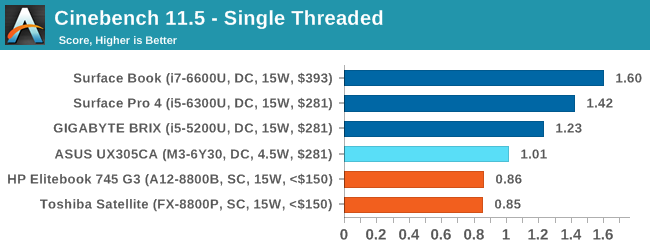


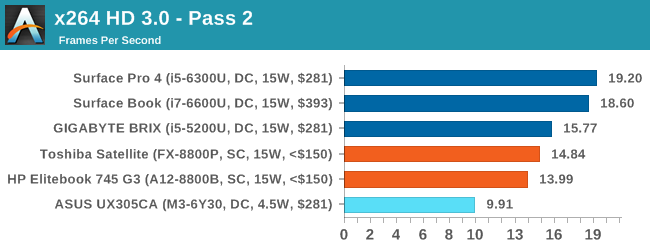
Most tests in this case favor the Intel 15W parts, with only POV-Ray being a fully multi-threaded integer workload pushing over the Broadwell i5-5200U. Ultimately this points to where Carrizo lies in performance: somewhere between Core M and Core i5, and it can sometimes lose to both in single threaded performance.
On the GPU and OpenCL tests:
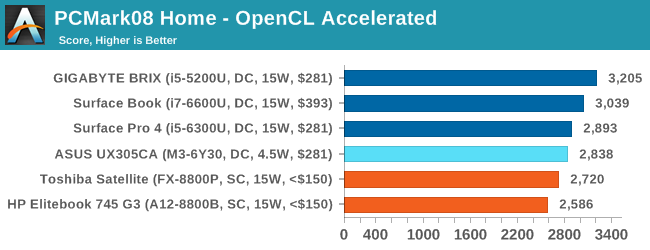
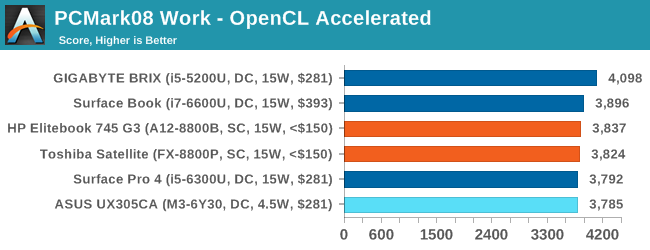

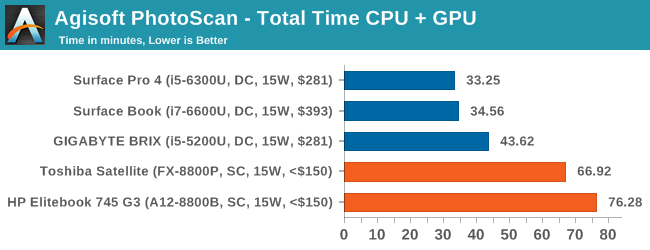
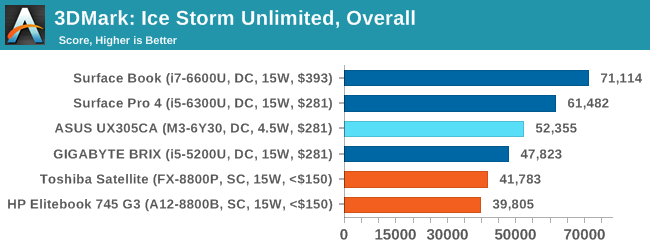

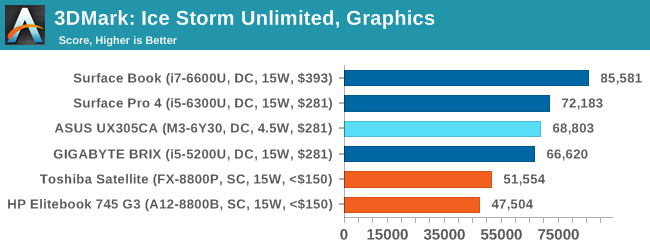

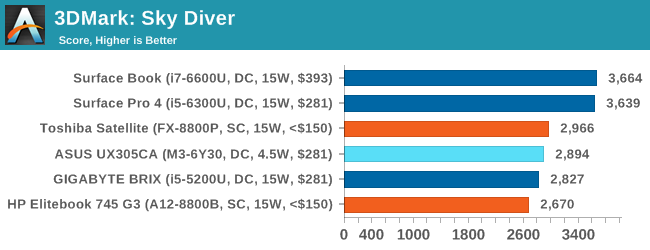
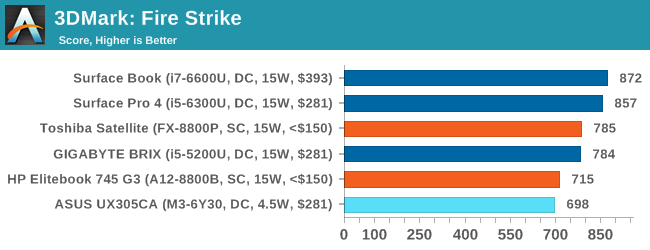
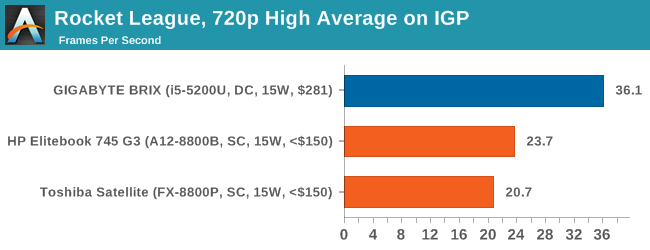
One of AMD’s big pushes is with gaming, OpenCL, and their Heterogeneous System Architecture (HSA). With all three markets, AMD wants to beat Intel. But here we have an issue – both of the AMD parts we have tested here are by default equipped with single channel memory, and may not even be dual channel capable if they share a device design with Carrizo-L (more on this in the next couple of pages). The use of single channel memory when Carrizo systems are sold essentially chokes the key parts of AMD’s offering.
A number of users might think it's unfair to show the results of two single channel Carrizo systems against dual channel Broadwell/Skylake systems, and we totally get that. After speaking internally with other editors however, we came across the situation that many Intel laptops come with dual channel memory as standard or a fixed memory arrangement to begin with. Looking at it closer, there is somewhat of a pattern:
| AMD Carrizo vs Intel Core Current Laptop Designs on the Market |
|||||||
| Name | Lenovo Y700-15ACZ |
HP Elitebook 745 G3 | HP Elitebook 840 G3 | Dell XPS 13 |
ASUS Zenbook UX303 | HP Envy 13t |
|
| Size | 15.6" | 14" | 14" | 13.3" | 13.3" | 13.3" | |
| Resolution | 1080p | 1080p | 1080p | 1080p | 1080p | 1800p | |
| Touch | No | No | No | No | Yes | No | |
| SoC | FX-8800P | A12-8800B | i5-6200U | i5-6200U | i5-6200U | i7-6500U | |
| µArch | Carrizo | Carrizo | Skylake | Skylake | Skylake | Skylake | |
| Integrated GPU | R7 512 SPs |
R7 512 SPs |
HD 520 24 EUs |
HD 520 24 EUs |
HD 520 24 EUs |
HD 520 24 EUs |
|
| Discrete GPU | R9-M380 4GB | - | - | - | - | - | |
| TDP | 35W+? | 15W | 15W | 15W | 15W | 15W | |
| Memory | 1x8GB DDR3L 1600 |
1x4GB DDR3L 1600 |
2x4GB DDR4 2133 |
2x4GB LPDDR3 1866 |
2x4GB DDR3L 1600 |
2x4GB DDR3L 1600 |
|
| Memory Channels |
Single Only |
Single / Dual |
Dual | Dual | Dual | Dual | |
| Storage | 1TB 5400 RPM | 256GB SSD |
128GB SSD |
128GB PCIe | 256GB SSD |
512GB SSD |
|
| Battery Size | 60 Wh | 45.76 Wh > 8.5h |
45.76 Wh | 56 Wh | 50 Wh > 7h |
45.76 Wh > 7.5h |
|
| Weight | 5.72 lbs | 3.41 lb | 3.41 lb | 2.7 lbs | 3.2 lbs | 3 lbs | |
| OS | Win10 Home | Win10/7 Pro |
Win7 Pro |
Win10 Pro | Win10 Home |
Win10 Home | |
| Warranty | 1Yr Base | 3Yr Parts 3Yr Labor |
1Yr Parts 1Yr Labor |
1 Year | 1 Year | 1 Year | |
| Price | £799 / $972 | $1049 | $1149 | $1049 | $899 | $1050 | |
After doing research for that table, there’s a clear relationship between the nature and style of the device. In each circumstance, the default Carrizo arrangement had only single channel memory whereas each Intel device came with dual channel as standard. Part of this is down to cutting costs, while part of it comes to the Carrizo/Carrizo-L shared design in the case of the Lenovo Y700. In each case, the system is being un-necessarily cut off from available performance due to choices at the point of product inception.
With that being said, there are some Intel designs that specifications wise do knock it out of the park. If there’s willing to be compromise a bit on the styling or warranty around this price point, then at the same price as the Elitebook G3 there can be an i7-6500U and a QHD+ display through the HP Envy 13t. But in each other case where the Intel system gets dual channel memory there’s also either a smaller drive or a more restrictive warranty on the Intel system. Or in the case of the Carrizo based Lenovo Y700, under $1000 gets a discrete graphics card, the 35W version of the APU, but it’s still limited to single channel memory by design, which is frustrating.
The situation looks a bit worse if we do a direct comparison between two equivalent price Lenovo Y700 systems:
| AMD Carrizo vs Intel Core Lenovo Ideapad Y700 15.6-inch |
|||
| Name | Lenovo Y700-15ACZ | Lenovo Y700-15 | |
| Visual | |||
| Size | 15.6" 1080p IPS | 15.6" 1080p IPS | |
| Touch | No | No | |
| Processor | AMD FX-8800P (35W) 2M/4T, 2.1-3.4 GHz |
Core i5-6300HQ (45W) 4C/4T, 2.3-3.2 GHz |
|
| Graphics | R6 + R9-M380 4GB | HD 530 + GTX 960M | |
| TDP | 35W + ? | 45W + 65W | |
| Memory | 1 x 8GB DDR3L-1600 Single Channel |
2 x 4GB DDR4-2133 Dual Channel |
|
| Storage | 1 TB 5400 RPM | 500 GB 5400 RPM | |
| Battery | 60 Wh | 60 Wh | |
| WiFi | 'Lenovo AC' | Intel 3165 802.11ac 1x1 | |
| Dimensions | 15.24 x 10.91 x 1.02" | 15.24 x 10.91 x 1.02" | |
| Weight | 5.72 lbs | 5.72 lbs | |
| Webcam | 1280x720 | 1280x720 | |
| OS | Windows 10 Home | Windows 10 Home | |
| Warranty | 1 Year | 1 Year | |
| Price | £799 / $972 | $980 | |
Here are the two Lenovo Y700 models at the same price, one with AMD and the other with Intel. The Intel part has a quad core i5 with a 45W TDP, a GTX 960M for graphics (similar in GFLOPS to the R9 M380) and dual channel memory. The models should compete similarly in gaming at 1080p, but if the AMD system allowed dual channel and CrossFire between the integrated APU and the discrete card it would handily get a boost. DirectX 12 might help here, if it can use both cards depending on the firmware, but at this point the positive for AMD over Intel is the larger hard disk. The Intel model has single stream 802.11ac wireless, which can be upgraded for $20, whereas the AMD wireless is not specified.
There’s no sugar coating the fact that there is a deficit in performance per watt between AMD’s best and Intel’s best in this regard, due to both the architecture and the process node. The price/performance ratio is a little bit trickier to digest, especially when so few AMD designs are by default equipped with enough memory and it can limit the maximum platform performance. In the case of the Y700 above, it’s because the product shares a platform with Carrizo-L making it limited to single channel memory, although I can't exactly find a Carrizo-L APU in a Y700 on the market.
Additional February 10th:
Since the publication of the review, a couple of things have come to our attention. Our pre-production Lenovo Y700, with both memory slots populated, was performing in single channel mode although our source for this sample assumed it was dual channel. Our testing confirmed single channel. However, the full retail version of the Y700 has an updated motherboard design to enable dual channel operation when both memory slots are populated with compatible memory. As far as well can tell, all Carrizo Y700 units at retail should be able to support dual channel memory.


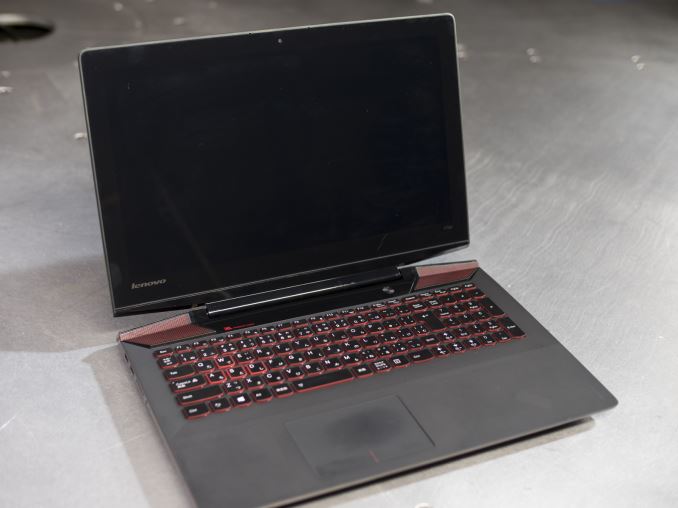
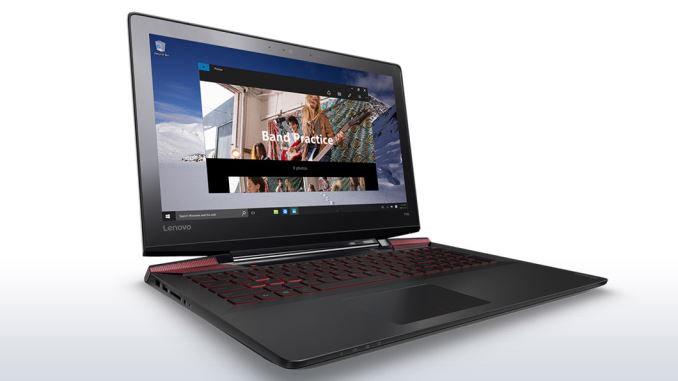








175 Comments
View All Comments
jakemonO - Wednesday, February 10, 2016 - link
no A12 core parts for the test? I can't find the A10 part on the HP websiote, only A8 & A12UtilityMax - Wednesday, February 10, 2016 - link
After a decade of hype since the ATI acquisition, nothing has changed. AMD has a massive OEM problem. Moreover, laptops have been outselling desktops for like a decade, yet AMD if you look at the history of AMD, it's hard to believe they ever really cared about portables. The Kaveri parts didn't even show up, while the Carrizo notebooks are already botched technology as explained in the article..gserli - Thursday, February 11, 2016 - link
I have to say that the $400 to $700 notebooks on sale are garbage.The IGPs are not strong enough for casual gaming like LOL and CS GO.
Crappy 5400RPM harddisk will make you want to throw the machine out of the window.
If you really need that little bit more performance.
Pay few hundred more. Or you can get a notebook that will hurt your arm if you carry it with one hand.
AMD needs to be more aggressive. Talk to the OEMs and give them better offer.
Convince them build a $700 notebook with 13 Inch 1080p IPS touch screen, 256GB SSD, 8GB RAM, A8 or A6 APU and below 1.5KG.
A lower end $600 one would work with 1366*768 IPS touch screen, 128GB SSD, 4GB RAM and A6 APU, below 1.5KG.
My $640 Asus TP300L is absolutely bullshit! I thought a mobile i5 would be enough for my daily use since I had a i5 desktop and was really satisfied with it.
CPU performance is not a issue nowadays. The IGP is slow, but I didn't expect it to be fast(Although the one on desktop is way more powerful).
The biggest problem is the GOD DAMN 5400RPM HARD DISK.
Not only did it affect the boot up speed. Every action I performed is awfully slow when there are some OS things running in background.
Only if I wait for 5 or 10 minutes after boot-up, then I can use it normally.
Please, kill all the 5400RPM Hard disk. They should not be in 2016.
farmergann - Thursday, February 11, 2016 - link
That's what I find so hilarious about all the Y700 6700hq lovers out there - all the CPU power in the world is relegated to potato status outside of b.s. benchmarks with that 5400rpm HDD. Save money with the FX8800p Y700 and buy an $80 250GB Samsung 850 Evo to slap in it...wow&wow - Thursday, February 11, 2016 - link
Will it be more appropriate to have "Additional" (Why not Update?) in the beginning, particularly the misleading pre-production stuff? Thanks for the article.farmergann - Thursday, February 11, 2016 - link
LOL, because the entire point of this article would be nullified. They didn't even bother comparing the FX8800p Y700 with the intels head to head outside of some DX9 garbage. Pitiful anandtech shills are pitiful. How many times did they mention Freesync? Yeah...silverblue - Friday, February 12, 2016 - link
To be fair, is there a point?xrror - Thursday, February 11, 2016 - link
"Some companies in the past have dealt with contra-revenue, selling processors at below cost or with deals on multiple parts when purchased together. Very few companies, typically ones with large market shares in other areas, have access to this. Some members of the industry also see it as not fighting fair, compared to actually just pricing the parts lower in the first place."I had to laugh so much as this. WHO COULD IT BE? MYSTERY!
It must be... Cyrix ! no? hrm. I give up. =P
dustwalker13 - Saturday, February 13, 2016 - link
still ... there is just no saving the bulldozer architecture, no matter how much they improve or iterate it.bulldozer and amd by proxy for normal users are synonyms for "just not as good as intel" and for a little more experienced users "that processor that cheated with its core count".
the few people who actually read articles like the one above and compare performance/value represent literally no market share.
the only way out for amd at this point is to create as much boom around their zen-cores as possible, get them out asap, hitch their little start to new buzzwords like hbm, old buzzwords like rage and hope they can actually deliver the performance figures needed in the first reviews to drive a wave of positive articles through the press. only then will they be able to get back into the market. i wish them the best, a surface 5 (non pro) with a low power zen apu on hbm sounds awsome ... i'd get one of those in a heartbeat.
yankeeDDL - Monday, February 15, 2016 - link
I own a Toshiba P50D-C-104. I read with interest this article and, albeit extremely helpful and rich of information, left some questions open, at least as far a I'm concerned.First of all, the P50D-C-104 costs <$600 and has an A10-8700P. I find this price range more relevant for home-users and, in general, for somebody interested in AMD offering.
1Kusd for a laptop with integrated GPU seems too expensive.
The P50D-C-104 has 2 DIMM slots; couldn't find for sure whether it is dual channel or not.
I am curios to know how it performs on some popular games against Intel's offering (at that price level, it would go against core i3, at best). In the page with comparison against Intel's offering there are almost only synthetic benchmarks: it would have been nice to compare on some actual games.
My point is that in the $1K range, there are many features that could add cost while not necessarily improving performance.